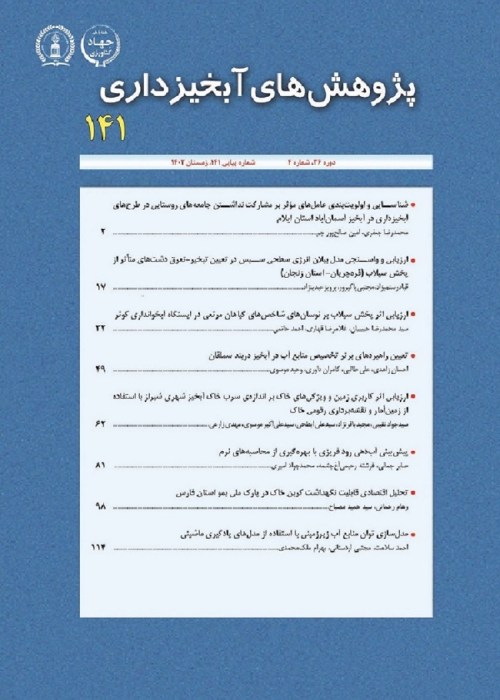The Role of Rainy Days in Predicting the Flow Duration Curve in Different Climates of Iran
Author(s):
Article Type:
Research/Original Article (دارای رتبه معتبر)
Abstract:
The Improvement and development of predictions in ungauged catchments require recognizing effective factors and understanding the interactions between different components of the catchments and hydrological response in different climatic zones. The most important factors affecting the flow duration curve (FDC) indices are precipitation and its characteristics. Since the flow duration curve represents the hydrologic response of watersheds, investigating and recognizing the effect of rainfall distribution on it can help to identify predictive factors for estimating the flow duration curve in ungauged catchments. The purpose of this study was to analyze the relationships between the number of rainy days and the indices FDC in the different climate zones of the country. Catchments of each climatic region were separated using the climate map of the country and overlapping it with the four-level border map of the watershed, and 314 hydrometric stations with the common period (1976–2011) in six climatic zones were selected. Flow duration curve using daily stream flow data were extracted by the Hydro Office software (2015) and indices of Q2, Q5, Q10, Q15, Q20, Q50, Q75, and Q90 were selected. The average of rainy days for each catchment was calculated and the regression relations between the FDC indices and the average of the number of rainy days in different climatic regions were extracted and analyzed. The results showed that the correlation between the indices of the first part of FDC with the number of rainy days in all selected watersheds of climatic zones had a weak and unreliable relationship for prediction and estimation of FDC in the ungauged catchments. But the relationships for the end parts of FDC (Q75 and Q90), were strong. It is noteworthy that the average coefficient of determination for the low flow indices (Q75 and Q90) with the average annual rainy days in catchments of different climatic zones was approximately equal to 0.66. This indicates the importance of the parameter of the number of rainy days as the predictor of the low flow indices associated with the end part of the FDC in different climatic zones. Therefore, it is suggested that the number of rainy days should be used as a predictive parameter for estimating the indices of the end section of FDC; its use for estimating other indices is not recommended.
Keywords:
Language:
Persian
Published:
Whatershed Management Research, Volume:32 Issue: 122, 2019
Pages:
60 to 72
magiran.com/p2002773
دانلود و مطالعه متن این مقاله با یکی از روشهای زیر امکان پذیر است:
اشتراک شخصی
با عضویت و پرداخت آنلاین حق اشتراک یکساله به مبلغ 1,390,000ريال میتوانید 70 عنوان مطلب دانلود کنید!
اشتراک سازمانی
به کتابخانه دانشگاه یا محل کار خود پیشنهاد کنید تا اشتراک سازمانی این پایگاه را برای دسترسی نامحدود همه کاربران به متن مطالب تهیه نمایند!
توجه!
- حق عضویت دریافتی صرف حمایت از نشریات عضو و نگهداری، تکمیل و توسعه مگیران میشود.
- پرداخت حق اشتراک و دانلود مقالات اجازه بازنشر آن در سایر رسانههای چاپی و دیجیتال را به کاربر نمیدهد.
دسترسی سراسری کاربران دانشگاه پیام نور!
اعضای هیئت علمی و دانشجویان دانشگاه پیام نور در سراسر کشور، در صورت ثبت نام با ایمیل دانشگاهی، تا پایان فروردین ماه 1403 به مقالات سایت دسترسی خواهند داشت!
In order to view content subscription is required
Personal subscription
Subscribe magiran.com for 70 € euros via PayPal and download 70 articles during a year.
Organization subscription
Please contact us to subscribe your university or library for unlimited access!


